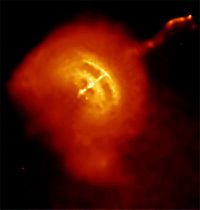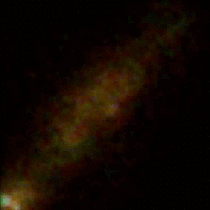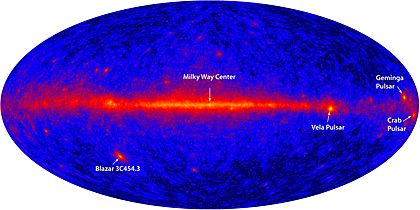Vela Pulsar facts for kids
| Observation data Epoch J2000 Equinox J2000 |
|
|---|---|
| Constellation | Vela |
| Right ascension | 08h 35m 20.65525s |
| Declination | -45° 10′ 35.1545″ |
| Apparent magnitude (V) | 23.6 |
| Astrometry | |
| Distance | 959+248 −163 ly (294+76 −50 pc) |
| Other designations | |
| Database references | |
| SIMBAD | data |
The Vela Pulsar is a special kind of star called a pulsar. It sends out radio waves, light, X-rays, and gamma rays. This pulsar is found in the constellation of Vela.
It is connected to the Vela Supernova Remnant. This is what is left after a huge star exploded. The original star exploded about 11,000 to 12,300 years ago. It was about 800 light-years away from us.
Contents
What is the Vela Pulsar?
The Vela Pulsar is the brightest pulsar we know of when looking at radio waves. It spins very fast, about 11 times every second. This means it completes one spin in just 89.33 milliseconds!
When it was first found, it was the fastest-spinning pulsar known. The leftover cloud from the star's explosion is moving outwards very quickly. It travels at about 1,200 kilometers per second.
How Bright is the Vela Pulsar?
The Vela Pulsar is the third brightest pulsar we can see with our eyes. It looks like a very faint star, with a brightness of 23.6 magnitude. It also gives off two flashes of light for every one radio pulse.
It is also the brightest object that constantly gives off high-energy gamma rays.
Sudden Speed Changes: Glitches
Sometimes, pulsars like Vela suddenly spin a little faster. These sudden speed-ups are called glitches. The Vela Pulsar is famous for its glitches.
It has a glitch about every three years. Scientists cannot predict exactly when a glitch will happen.
Watching a Glitch Happen
On December 12, 2016, scientists saw a Vela Pulsar glitch live. They used a large radio telescope to watch it. This was the first time a glitch was observed as it happened.
During this glitch, the pulsar missed one pulse completely. The pulse right before it was very wide. The two pulses after the glitch had low linear polarization. The whole glitch process happened in less than five seconds.
Another glitch happened on July 22, 2021. After this glitch, the pulsar's spin period became shorter. It changed by about one part in a million.
Discoveries and Research
In 1968, astronomers in Australia linked the Vela Pulsar to the Vela Supernova Remnant. This was important proof that supernova explosions create neutron stars. Neutron stars are what pulsars are made of.
Understanding Vela X
Early studies in the 1970s looked at the Vela Pulsar and something called Vela X. They found that these were separate but related objects. The name Vela X was used for the entire supernova remnant.
Later, in 1980, scientists found that Vela X was a pulsar wind nebula. This is a cloud of gas and energy powered by the pulsar itself. It is inside the fainter supernova remnant.
Naming the Vela Pulsar
The Vela Pulsar is sometimes called Vela X. But this can be confusing because Vela X is also the name for the nebula. In the 1950s, a radio survey found three strong radio sources: Vela X, Vela Y, and Vela Z.
These sources are near another supernova remnant called Puppis A. It also gives off strong X-rays and radio waves.
It is important not to confuse the Vela Pulsar or its nebulae with Vela X-1. Vela X-1 is a different type of star system. It is a high-mass X-ray binary system, which means it has two stars orbiting each other.
Vela Pulsar in Music
The sounds of the Vela Pulsar have even been used in music! A French composer named Gérard Grisey used the signals from Vela. He also used signals from another pulsar, PSR B0329+54. He turned these signals into sounds for his music piece Le noir de l'étoile (1989–90).
Gallery
-
Cycle of pulsed gamma rays from the Vela pulsar
See also
 In Spanish: Pulsar de Vela para niños
In Spanish: Pulsar de Vela para niños




